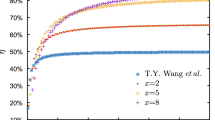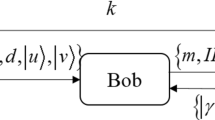Abstract
We propose a quantum digital signature in a network consisting of one signer, multiple verifiers, and a trusted center (TC). The protocol guarantees that messages and signed messages are not counterfeited, and it authenticates the source of the messages. In addition, a signer (or a verifier) cannot, at a later time, deny having signed (received) the message. Theoretically, our quantum digital signature guarantees the security through quantum mechanics.





Similar content being viewed by others
References
Pfitzmann, B.: Sorting out signature schemes. In: CCS ‘93 Proceedings of the 1st ACM Conference on Computer and Communications Security, pp. 74–85 (1993)
Rivest, R.: Cryptography, pp. 717–775. Elsevier, Amsterdam (1990)
Rivest, R.L., Shamir, A., Adleman, L.: A method for obtaining digital signatures and public-key cryptosystems. Commun. ACM 21, 120 (1978)
Shor, P.: Polynomial-time algorithms for prime factorization and discrete logarithms on a quantum computer. SIAM Rev. 41, 303 (1999)
Shor, P.W.: Algorithms for Quantum Computation: Discrete Logarithms and Factoring, pp. 20–22. IEEE Computer Society Press, Los Alamitos (1994)
Shor, P.W.: Polynomial-time algorithms for prime factorization and discrete logarithms on a quantum computer. SIAM J. Comput. 5, 1484 (1997)
Gottesman, D., Chuang, I.L.: Quantum digital signatures. e-print arXiv:quant-ph/0105032 (2001)
Buhrman, H., Crepeaum C., Gottesmanm D., Smith, A., Tapp, A.: Authentication of quantum messages. In: Proceedings of 43rd Annual IEEE Symposium on the Foundations of Computer Science (FOCS ‘02), pp. 449–458 (2002)
Zeng, G.H., Keitel, C.H.: Arbitrated quantum-signature scheme. Phys. Rev. A 65, 042312 (2002)
Curty, M., Lutkenhaus, N.: Comment on “Arbitrated quantum-signature scheme”. Phys. Rev. A 77, 046301 (2008)
Zeng, G.H.: Reply to “Comment on ‘Arbitrated quantum-signature scheme’”. Phys. Rev. A 78, 016301 (2008)
Lee, H., Hong, C.H., Kim, H., Lim, J., Yang, H.J.: Arbitrated quantum signature scheme with message recovery. Phys. Lett. A 321, 295 (2004)
Wang, J., Zhang, Q., Liang, L.M., Tang, C.J.: Comment on: “Arbitrated quantum signature scheme with message recovery”. Phys. Lett. A 347, 262 (2005)
Li, Q., Chan, W.H., Long, D.Y.: Arbitrated quantum signature scheme using Bell states. Phys. Rev. A 79, 054307 (2009)
Zou, X., Qiu, D.: Unextendible product bases and extremal density matrices with positive partial transpose. Phys. Rev. A 84, 042325 (2010)
Yoon, C.S., Kang, M.S., Lim, J.I., Yang, H.J.: Quantum signature scheme based on a quantum search algorithm. Phys. Scr. 90, 15103 (2015)
Zhang, P., Zhou, X.Q., Li, Z.W.: Identification scheme based on quantum teleportation for wireless communication networks. Acta Phys. Sin. 63, 130301 (2014)
Clarke, P.J., Collins, R.J.: Experimental demonstration of quantum digital signatures using phase-encoded coherent states of light. Nat. Commun. 3, 1174 (2012)
Maurer, P.C., et al.: Room-temperature quantum bit memory exceeding one second. Science 336, 1283 (2012)
Robert, J.C., Ross, J.D., Vedran, D., Petros, W., Patrick, J.C., Erika, A., John, J., Gerald, S.B.: Realization of quantum digital signatures without the requirement of quantum memory. Phys. Rev. Lett. 113, 040502 (2014)
Ekert, A.: Quantum cryptography based on Bell’s theorem. Phys. Rev. Lett. 67, 661 (1991)
Yang, Y.G., Zhou, Z., Teng, Y.W., Wen, Q.Y.: Arbitrated quantum signature with an untrusted arbitrator. Eur. Phys. J. D 61, 773–778 (2011)
Liu, F., Zhang, K., Cao, T.: Security weaknesses in arbitrated quantum signature protocols. Int. J. Theor. Phys. 53, 277 (2014)
Kang, M.S., Hong, C., Heo, J., Lim, J.I., Yang, H.J.: Quantum signature scheme using a single qubit rotation operator. Int. J. Theor. Phys. 54, 614–629 (2015)
Luo, M.X., Chen, X.B., Yun, D., Yang, Y.X.: Quantum signature scheme with weak arbitrator. Int. J. Theor. Phys. 51, 2135 (2012)
Kang, M.S., Choi, H.W., Pramanik, T., Han, S.W., Moon, S.: Universal quantum encryption for quantum signature using the swap test. Quantum Inf. Process. 17, 254 (2018)
Boström, K., Felbinger, T.: Deterministic secure direct communication using entanglement. Phys. Rev. Lett. 89, 187902 (2002)
Wójcik, A.: Eavesdropping on the “Ping-Pong” quantum communication protocol. Phys. Rev. Lett. 90, 157901 (2003)
Pavičić, M.: In quantum direct communication an undetectable eavesdropper can always tell Ψ from Φ Bell states in the message mode. Phys. Rev. A 87, 042326 (2013)
Menezes, A.J., van Oorschot, P.C., Vantone, S.A.: Handbook of Applied Cryptography. CRC Press, Boca Raton (1996)
Forouzan, B.A.: Cryptography and Network Security. Mcgraw Hill International Edition, New York (2007)
Kashefi, E., Kerenidis, I.: Statistical zero knowledge and quantum one-way functions. Theor. Comput. Sci. 378(1), 101–116 (2007)
Luo, M.X., Chen, X.B., Yun, D., Yang, Y.X.: Quantum public-key cryptosystem. Int. J. Theor. Phys. 51, 912–924 (2012)
Hwang, W.Y.: Quantum key distribution with high loss: toward global secure communication. Phys. Rev. Lett. 91, 057901 (2003)
Deng, F.G., Long, G.L.: Controlled order rearrangement encryption for quantum key distribution. Phys. Rev. A 68, 042315 (2003)
Branciard, C., Gisin, N., Kraus, B., Scarani, V.: Security of two quantum cryptography protocols using the same four qubit states. Phys. Rev. A 72, 032301 (2005)
Li, C.Y., Li, X.H., Deng, F.G., Zhou, H.Y.: Efficient quantum secure communication with a publicly known key. Chin. Phys. B 17, 2352 (2008)
Shen, D., Ma, W., Wang, L.: Two-party quantum key agreement with four-qubit cluster states. Quantum Inf. Process. 13, 2313–2324 (2014)
Curty, M., Xu, F., Cui, W., Lim, C.C.W., Tamaki, K., Lo, H.: Finite-key analysis for measurement-device-independent quantum key distribution. Nat. Commun. 5, 3732 (2014)
Zhang, M.H., Fi, H.F., Xia, Z.Q., Feng, X.Y.: Semiquantum secure direct communication using EPR pairs. Quantum Inf. Process. 16, 117 (2017)
Stinson D.R.: Cyrptography: theory and practice, 3rd edn, pp. 281–316. Chapman and Hall/CRC (2005)
Lim, C.C.W., Curty, M., Walenta, N., Xu, F., Zbinden, H.: Concise security bounds for practical decoy-state quantum key distribution. Phys. Rev. A 89, 022307 (2014)
Amiri, R., Wallden, P., Kent, A., Andersson, E.: Secure quantum signatures using insecure quantum channel. Phys. Rev. A 93, 032325 (2016)
Devetak, I., Winter, A.: Distillation of secret key and entanglement from quantum states. Proc. R. Soc. Lond. A 461, 207 (2005)
Acknowledgements
This work was supported by the R&D Convergence Program of NST (National Research Council of Science and Technology) of Republic of Korea (Grant No. CAP-18-08-KRISS) and by Basis Science Research Program through the National Research Foundation of Korea (NRF) funded by the Ministry of Education (No. 2019R1I1A1A01042699).
Author information
Authors and Affiliations
Corresponding author
Additional information
Publisher's Note
Springer Nature remains neutral with regard to jurisdictional claims in published maps and institutional affiliations.
Rights and permissions
About this article
Cite this article
Hong, C., Jang, J., Heo, J. et al. Quantum digital signature in a network. Quantum Inf Process 19, 18 (2020). https://doi.org/10.1007/s11128-019-2510-4
Received:
Accepted:
Published:
DOI: https://doi.org/10.1007/s11128-019-2510-4




